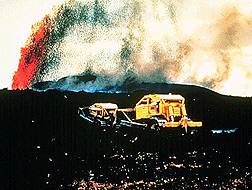

 |
Dealing with Volcanic Threats Photo: Courtesy
of NGDC/NOAA What do you do when the volcano in your own back yard
erupts? Call your family volcanologist? ("Sandbag the river bank and call me in the
morning....") What if it is your responsibility to make an evaluation or to take
action? First, you must gather information to determine the current situation (seismic
activity, active eruption, etc.) and evaluate the potential type and magnitude of hazards
associated with the current situation. Then you must choose a response to the threat.
Options include, but are not restricted to the following: Photo: Courtesy
of NGDC/NOAA What do you do when the volcano in your own back yard
erupts? Call your family volcanologist? ("Sandbag the river bank and call me in the
morning....") What if it is your responsibility to make an evaluation or to take
action? First, you must gather information to determine the current situation (seismic
activity, active eruption, etc.) and evaluate the potential type and magnitude of hazards
associated with the current situation. Then you must choose a response to the threat.
Options include, but are not restricted to the following:1. Ignore. The situation may warrant no further concern. Remember that any action taken will have consequences. Some, like #2 and #3, cost money for equipment and/or people--money that will have to come out of somebody's pocket. Any kind of access restriction or evacuation will cost money, disrupt lives, and take time. Businesses, like hotels or grocery stores in a restricted area, will lose money due to loss of customers; others, like lumber companies and mines, will lose access to their means of production. You will have to balance the potential risk to public safety against the needs and interests of private individuals. In our society, individuals can often exert excessive pressure on decision makers to choose courses of action that may not be in the public interest (remember St. Pierre). As an evaluator or decision maker, you need to be as honest and accurate in your judgments as possible; because if you are wrong, you may cause needless disruption, economic hardship, or the loss of life.
[ Volcanoes & Climate ] [ Monitoring Volcanoes ] [ Home ] [ Teacher Pages ] [ Modules & Activities ] |
HTML code by Chris Kreger
Maintained by ETE Team
Last updated November 10, 2004
Some images © 2004 www.clipart.com
Privacy Statement and Copyright © 1997-2004 by Wheeling Jesuit University/NASA-supported Classroom of the Future. All rights reserved.
Center for Educational Technologies, Circuit Board/Apple graphic logo, and COTF Classroom of the Future logo are registered trademarks of Wheeling Jesuit University.